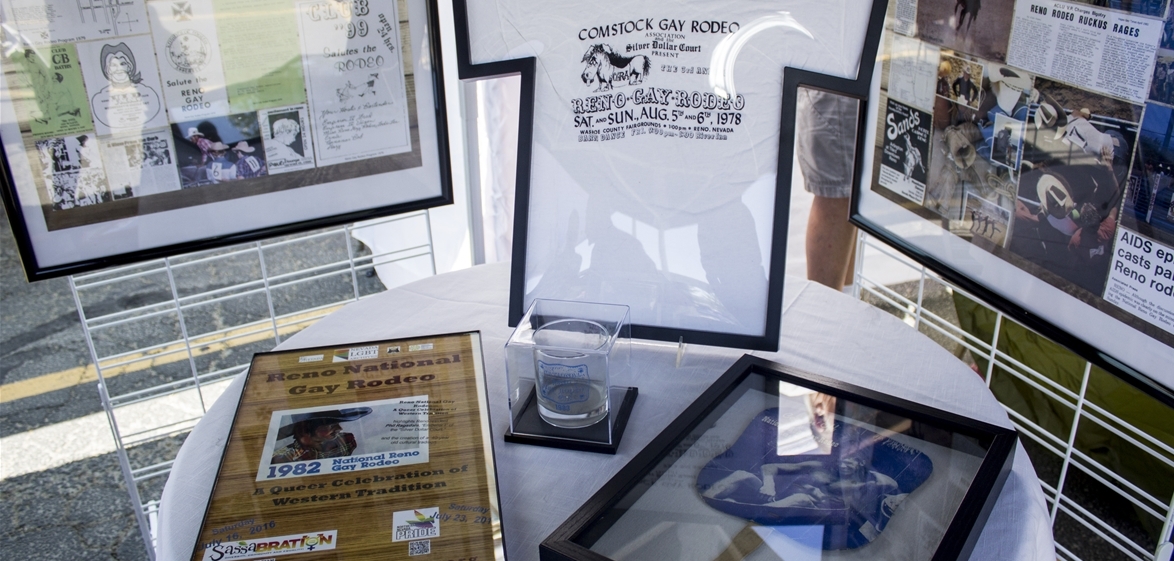Academic scholarship regarding the gay community and its place in American history is still in many ways in its infancy. History's first draft, particularly given events of the past three decades, from the onset of the HIV/AIDS epidemic in the gay community to last June's landmark U.S. Supreme Court decision affirming the constitutional right for same-sex marriage, is still being written.
Nicholas-Martin Kearney and his husband, Jeff Auer, both University employees, are helping northern Nevada and the rest of the country fill in the archival gaps in looking at the massive change that the LGBTQ community has experienced. Kearney, an administrative assistant in Core Humanities and Auer, an adjunct instructor in Humanities at 365 Learning, have established a nonprofit organization dedicated to reclaiming historical artifacts significant to the LGBTQ community, Nevada LGBT Archives.
Their first exhibition, "Reno National Gay Rodeo: A Queer Celebration of Western Tradition," celebrates the 40th anniversary of Gay Rodeo sport, its historical significance to Washoe County and the University, and the philanthropic accomplishments of one of the local driving forces behind the rodeo, the "Silver Dollar Court." The exhibit was on display at downtown Reno's Wingfield Park on July 23 during the Northern Nevada Pride Parade festival.
The exhibit, and the nonprofit organization that created it, was an offshoot of Auer's scholarly activity as a doctoral candidate in the Department of History at the University. Since moving to Reno about a decade ago, he has focused on the historical place and significance of gay men in Reno. He's currently researching and co-writing a statewide history of LGBT people for the Nevada State Historic Preservation Office.
Auer had been commissioned by the National Park Service to write a field study on any city in the American southwest, as part of a larger Park Service LGBT Heritage Initiative.
"Jeff chose Reno, knowing that there is still a strong element of uniqueness to this town, that there are places and spaces that hadn't yet been demolished, that could reach historic preservation status," Kearney said.
"Jeff started his research, and very quickly realized there was nothing here," Kearney added, noting that there was a paucity of archival material on the subject. He said UNLV had a very limited amount, as well as bits and pieces of material in the University's Special Collections.
For Kearney, whose background is in the performing arts, a "light bulb went off," he said.
"There was no statewide repository," he said. "So we started the research into what an archive might look like, and more specifically, what would Nevada's look like?"
Over the past three years, Auer and Kearney have tirelessly worked to establish their 501(c)3 non-profit, which became official in January.
"Everything has been so dispersed throughout the country, and this was an opportunity to reclaim artifacts, preserve them, and showcase them in digital and traveling exhibitions," Kearney explained.
Given the events of the past few years, particularly last June's Supreme Court ruling, the time seems to have come for academics to hone in on the complex themes and to excavate and enliven key historical moments to help a wide range of audiences better understand the LGBT movement.
"The last two years have been truly life-changing in the LGBT community," Kearney said. "The rules have changed. We are suddenly no longer second-class citizens. Now we are working on understanding what it all means - what language do we use, and when do we use it? Our effort to create a repository for this information is really snowballing right now."
The July 23 exhibition focused on one of the seminal events in the history of the community. The sport of Gay Rodeo finds its roots in Reno, where on Oct. 2, 1976, the Reno Gay Rodeo was first held. It was founded in 1975 by Phil Ragsdale, whose philanthropic group, the Silver Dollar Court, was looking to partner with Washoe County to raise funds for the elderly and individuals suffering from Muscular Dystrophy. Ragsdale also hoped to show that the LGBT community, according to Auer, "... was not frightened easily and could do all the events that the 'rough and tough' cowboy could." By 1982, the event had grown substantially, drawing more than 20,000 spectators.
"And that's our first exhibition, the 40th anniversary of the Gay Rodeo, which was the brainchild of this one man from Reno, Phil Ragsdale, a man with a big heart who wanted to help others," Kearney said. "It's a tradition now within the gay community that goes far beyond rodeo."
The exhibition was also recently displayed at the annual diversity celebration in Carson City.
"Folks who made it out to the celebration were stunned," Kearney said. "There were photos they hadn't seen in 30 years."
Speaking more broadly, Kearney said the effort of the past three years, while time-consuming and painstaking, has been in some ways just the beginning of a larger effort. Each day, he noted, with the passage of time history in this still emerging academic field is being lost, as primary sources who experienced key events first-hand are passing away.
"As an archivist, that's one of the biggest challenges," he said. "I want to move fast enough, and raise enough money, to make sure we gain and record all of the oral histories that we can, because this is a part of our history that we are now losing. And, we owe it to all of those who are no longer with us to allow their work and their experiences to be seen in the larger context of who are now, as a people.
"Twenty, thirty, forty years ago, these people were marginalized. This is our opportunity to make sure that all of these colors will be fully present in the fabric of what we are trying to save. Now we have a chance to create a statewide resting place for gay archives. It's an amazing time to be alive, and to be doing something like this."












